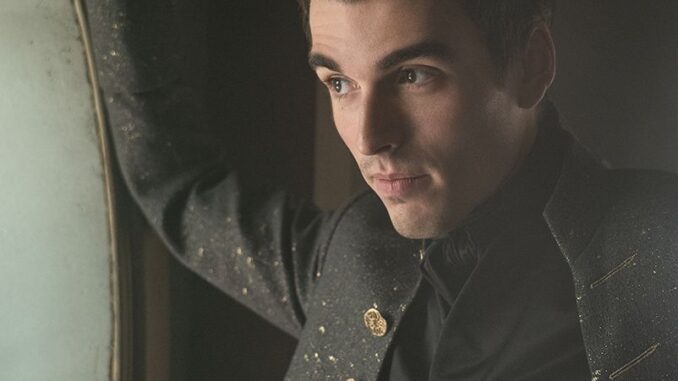
The actor plays the titular monarch’s husband on the latest addition to the Bridgerton world.
In a way, Queen Charlotte wouldn’t be what it is without Succession. Yes, the two shows take place in entirely separate time periods and countries, and for all their different might as well not inhabit the same world, but there is something that ties the two together.
“For the first few weeks of filming, I was a bit of a deer in the headlights,” says Corey Mylchreest, who plays King George III on Queen Charlotte: A Bridgerton Story, the new series streaming now on Netflix. “But the final bit of me getting into character would be putting on this ring that had George’s initials on it, and then—because part of my process was putting music together on a playlist—listening to a specific track.”
What was the song that helped the young actor prepare to play his first major role? “It’s one of the themes from Succession,” Mylchreest says. He pulled a notebook into the frame of our Zoom call and showed me a photo of Jeremy Strong in character as Kendall Roy. “There’s something about this frame and the music that was playing at that time,” Mylchreest says. “[Kendall] looks like a man who has resigned himself to his fate, his duty, and the role that he had to play, and there was something in that I found incredibly heavy. That is something that George wakes up and goes to sleep with every single day. And it was nice to pin everything into that moment [with the song] just before filming, because that’s the heartbeat of who he is.”
Although King George, based on the real-life monarch, might not be exactly like one of the Roy children, he’s not without problems of his own. When viewers of Queen Charlotte first meet him, he’s being not-so-gently pushed by his determined mother to marry, have children, and cement the future of the monarchy. When he meets Charlotte and decides to ask for her hand, the prospect of spending a life together doesn’t quite seem to thrill him; and once the two are married, it becomes abundantly clear that their concepts of a shared life involve radically different amounts of time actually shared.
“He’s an incredibly complicated character, and a blessing of a character to be able to play,” Mylchreest says. “Throughout the course of the series, the places that George goes to… well, I’ll wait for everyone to tune in and see it, but there’s an entire palette and spectrum of emotions and physical places that are demanded of whoever it is would’ve been to play George. And I’m very lucky that it was me.”

While Mylchreest might be hesitant to overshare about the character, whose experiences—including mysterious health issues—account for some of the series’ biggest plot twists, curious fans could look for more in the very same place the actor did himself: the library. “Maybe it’s my training, but I went straight to the books,” he says of finding his way into playing George. “And lucky for me, there were 20,000 pages of his personal diaries, journals, and letters that were released in 2015 but had been part of the Royal Libraries since he was around. There was a beautiful, very telling book written by a great historian called Andrew Roberts, and so I read that—and because it’s recent, it has all the new findings from these 20,000 pages. I also bought cork boards and I’d make loads of notes and have them all up in my room.”
(Putting up notes seems to be something of a theme for Mylchreest. “I was talking to my mom about it the other day, and she reminded me that when I was about five, I would go around slapping Post-it notes on the walls that would say, ‘I will be a film director or I will be a film actor,’” he says “So, I invented visualization for myself at a very young age.”)
Still, Mylchreest’s portrayal of the complicated Crown wasn’t just about doing homework. “Obviously it’s not a documentary that we’re making, so I tried to blend all that research that I’d done with what Shonda Rhimes had written beautifully,” he says. “And then I was trying to bring my own imagination and personal understanding of life and what it is to be someone. Luckily, there was such a wealth of information, both in the script and in all the research that I did, that it left me very free. I think that creatively, if you have more constraints, then you are actually more unrestricted. A blank canvas is much harder to paint on than something that already has an idea behind it, and I went with that.”
The approach seems to have worked. Rhimes, who wrote and produced the series, says, “Corey brought something so different than I ever expected. I wasn’t sure how the character’s illness was going to play out or how it was going to look on screen, and he created that. I don’t like to tell people exactly what to do, but it’s exciting to me that he found a way to embody what I was talking about so well.”
